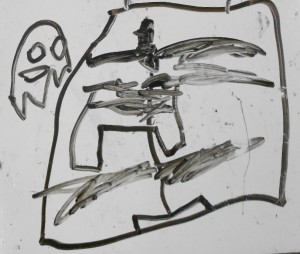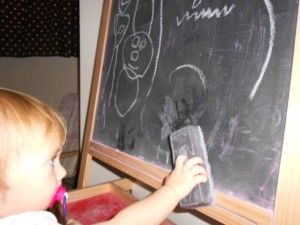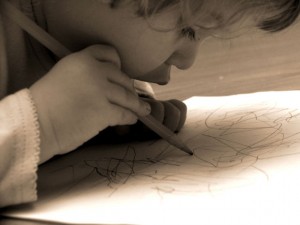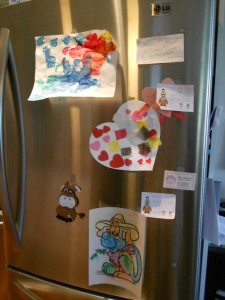Helping Children Learn to Play with Art Toys
Not all children are born artists, but they can all enjoy playing with art toys. Helping children discover how to play with art toys is where we come into the picture. Crayons, pencils, paints, brushes, markers, chalk, paper, scissors, glue, and other art supplies are more than toys. They are magic wands that reveal a world of color and shapes right at the end of a child’s fingertips–once they know who to play with them.
 All children like to have an effect on something in their world. This can be making a noise with a spoon and a lid to bang on or making a mark with a crayon on a wall. That’s a sort of very early graffiti. (Parents mathematical formula: The lighter the wall paint, the darker the crayon color.) We can channel this drive with paper–sometimes.
All children like to have an effect on something in their world. This can be making a noise with a spoon and a lid to bang on or making a mark with a crayon on a wall. That’s a sort of very early graffiti. (Parents mathematical formula: The lighter the wall paint, the darker the crayon color.) We can channel this drive with paper–sometimes.
 Chalk is one of the easier materials for young hands to use–and to clean up. We can show kids how to make marks on paper, easels, and sidewalks. Once kids have developed more coordination, you can introduce them to markers, crayons, and paper, instead of walls.
Chalk is one of the easier materials for young hands to use–and to clean up. We can show kids how to make marks on paper, easels, and sidewalks. Once kids have developed more coordination, you can introduce them to markers, crayons, and paper, instead of walls.
 Paints are exciting but need a little more preparation. You can spread newspapers to cover the table and floor. Some parents like to let kids play with paints with no clothes on and then just pop the kidlets into the bath. Paint dabbers are less messy but not as sensory as spreading paint all around with hands. To encourage children who are reluctant or hesitant, pudding is a very appealing kind of fingerpaint.
Paints are exciting but need a little more preparation. You can spread newspapers to cover the table and floor. Some parents like to let kids play with paints with no clothes on and then just pop the kidlets into the bath. Paint dabbers are less messy but not as sensory as spreading paint all around with hands. To encourage children who are reluctant or hesitant, pudding is a very appealing kind of fingerpaint.
 Children’s first marks will be random scribbles and colors. As small muscles become more coordinated, kids will begin to intentionally draw lines and shapes. Pictures become more or less representative of real objects. For some adults, me included, drawing is a challenge. There are some super books for kids that give step-by-step pictures for drawing such as the Usborne books and ones by Ed Emberley.
Children’s first marks will be random scribbles and colors. As small muscles become more coordinated, kids will begin to intentionally draw lines and shapes. Pictures become more or less representative of real objects. For some adults, me included, drawing is a challenge. There are some super books for kids that give step-by-step pictures for drawing such as the Usborne books and ones by Ed Emberley.
**Pictures do not always have to ‘be’ something. Kids like to simply create. Instead of asking children what a drawing is, you can ask how they felt when they were making their work /play of art. A neutral way to ask is to invite a child with the words, “Tell me about this.” Usually, art play is individual and self-directed but we can also play together. Kids love something that they have made with a grownup or a friend.
 Pictures and various forms of art are another way for kids, and adults, to express themselves. One day, hopefully, there will be museums of children’s art. In the meantime, the fridge or hallway can be the display space. A framed piece of children’s art work / play makes a lovely gift and boosts their sense of worth.
Pictures and various forms of art are another way for kids, and adults, to express themselves. One day, hopefully, there will be museums of children’s art. In the meantime, the fridge or hallway can be the display space. A framed piece of children’s art work / play makes a lovely gift and boosts their sense of worth.
Although it’s called art Work, it is a form of Play. As parents and caregivers, we are children’s first teachers and their first play coaches. Have you shared with your child some ways how to play with art toys?
